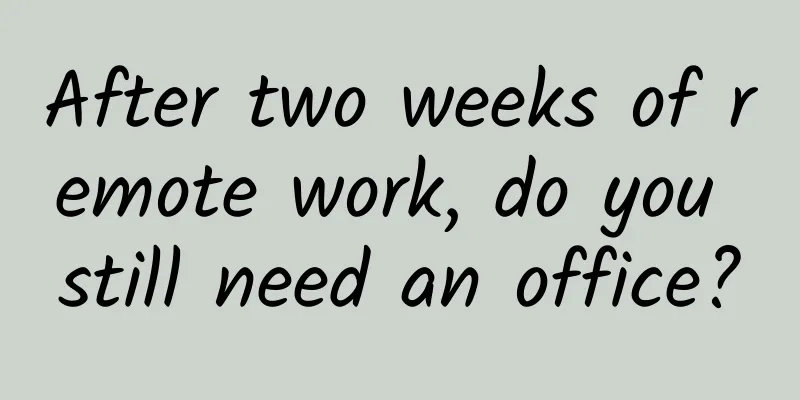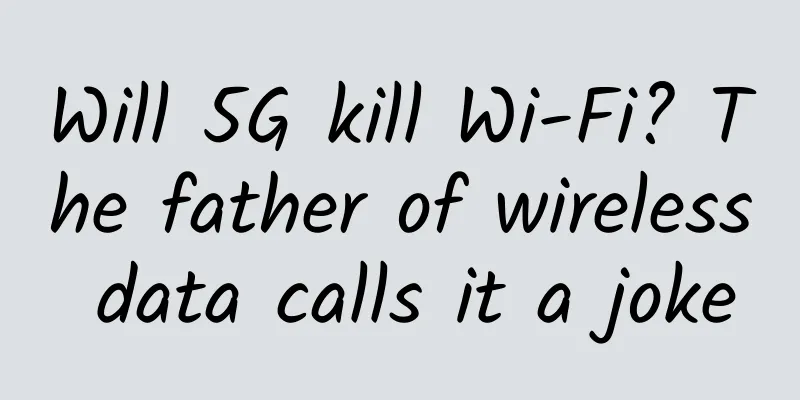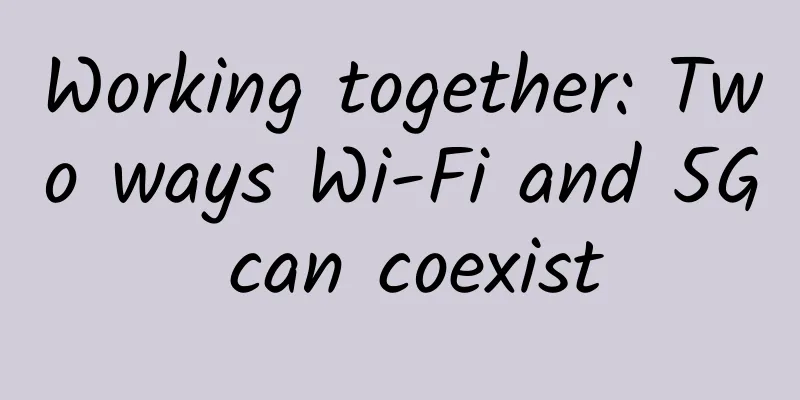After two weeks of remote work, do you still need an office?

|
【Abstract】If the Industrial Revolution drove people to the office, then the Digital Revolution is driving them back home. In the book Remote: Office Not Required, author Jason Fried seemed a little gloating: "Dedicated to all my friends who are stuck in traffic." He is also the founder of the remote collaboration software Basecamp. Robert Propst, the designer of the cubicle-shaped office, was still apologizing for the cubicle he designed in 1968 in his later years. "Not all companies are so smart and pursue progress. Many rude operators just make some small and narrow cubicles and cram people into them. They are all as simple as rat nests." On the one hand, people are suffering from these two kinds of physical and mental unfreedom, and on the other hand, Internet companies are following Google's example and transforming their offices into open ones. The trend of shared offices is blowing, and remote work is rising under the epidemic. So, will the traditional office eventually disappear? Before cubicles were designed, and before the Industrial Revolution gave rise to more efficient factories, farmers and businessmen often worked from home. The division between their living and working areas was relatively vague. Later, due to the desire for efficiency, people separated their living and working areas and created offices. But with the evolution and popularization of the Internet, mobile terminals and communication tools, people seem to have been driven back home. In this sense, remote work has completed a round of revival. Go out of the house and go to the office Before the Industrial Revolution, with the emergence of the first home offices, people needed a centralized location to manage state affairs. The first administrative buildings appeared. The Uffizi Gallery is one of them, built by the Medici family in Florence in 1581. Because it was used as a government office before the 18th century, the Uffizi Gallery is considered the predecessor of the office. This oldest office has a history of nearly 500 years.
Between 1760 and 1840, the first industrial revolution pushed the workforce from “small workshops” to “large factories” with more centralized production, and people went out to work. In the early 19th century, the birth and innovation of telephones, telegraphs, typewriters, and public electricity brought about the first change in the modern American office. After World War II, perhaps due to the resistance to Nazi totalitarianism and the aversion to surveillance, a more casual office layout began to become popular in Europe. People no longer sat in rows, but could walk around and chat, with only screens and green plants to separate private spaces. This design, called "office landscape" (Bürolandschaft), became popular.
In 1968, designer Robert Propst improved on the “office landscape” and designed the cubicle. It was a set of modular desks and partitions that could be deployed from the desktop. “Propst wanted to bring a touch of democracy to the office, but he created a set of office structures and a billion-dollar industry, and gave slavery a more concrete form,” wrote Pagan Kennedy in The New York Times. "In the 1990s, with the fanatic fantasy brought by the Internet bubble, various utopian office spaces emerged one after another: offices that looked like miniature cities, offices with bowling alleys, office parks comparable to university campuses, and small and comfortable offices that looked like decorated home garages or entertainment rooms." Nikil Saval described it in his book "Compartments: The Evolution of the Office". Google, which advocates open office, is a typical example. In addition, it also removed the partitions on the desks in the hope that employees could reduce barriers and enhance communication. These companies seem to be taking on Propst's wishes to make the office more democratic and open. At the same time, Google also allows some employees to work remotely under certain circumstances. The company has created a cloud-based office suite that is providing services to the world. Last year, Google also optimized its search engine for users seeking remote work. Job seekers only need to set their location as "work from home" when searching to find their target more accurately. This also indirectly shows that there are more and more remote workers. From home workshops to factories to cubicles, the office has been changing. Now, people are tearing down the partitions. In the future, they may tear down the office altogether. What do you need an office for if you have computers? According to a report released by FlexJobs, a well-known American recruitment website, the number of remote workers in the United States increased by 159% between 2005 and 2017, based on non-self-employed people who work remotely for more than half of their working hours. In 2017, a total of 4.7 million people worked remotely, accounting for 3.4% of the total US workforce (up from 2.9% in 2015). Nowadays, hashtags such as #WorkFromAnywhere and #DigitalNomad are appearing more and more frequently on social media. "Digital nomads" are happy to promote this "work from anywhere" approach that is not bound by time and geography. However, the "remote work" they advocate, which requires getting out of the office, is not a new concept. The concept was first proposed in 1973, even before the advent of the world's first personal computer. That year, the United States was in the midst of a national energy crisis. Former NASA engineer Jack Nilles proposed that telecommuting was an innovative way to solve problems such as urban expansion, traffic congestion, and the lack of non-renewable resources. If we trace back further, before the Industrial Revolution gave birth to more efficient factories, farmers and businessmen often worked at home. With the continuous evolution of the Internet, mobile terminals and communication tools, people have the right to be "absent". If the Industrial Revolution drove people to the office, the Digital Revolution is driving them back home.
In 1975, IBM launched the ancestor of modern personal computers, the IBM 5100. This 25-kilogram computer was equipped with a 1.9MHz processor, a maximum of 64KiB of memory, a 5-foot black-and-white display, and a QWERTY keyboard. Six years later, IBM released the first personal computer, the IBM 5150 (IBM PC), with a starting price of $1,565. In 1979, IBM conducted an experiment with five employees to ease office mainframe congestion. IBM installed square green-screen terminals in the employees' homes, allowing them to work remotely from home. By 1983, the company had 2,000 employees working remotely. Thirty years after the experiment began, IBM announced in a report that the company had about 386,000 employees in 173 countries, 40% of whom did not stay in the office at all. More than 58 million square feet of offices were demolished, saving nearly $2 billion. In 1983, ARPANET, the predecessor of the Internet, began to adopt TCP/IP, a common protocol between all hosts, which gave birth to the modern Internet. In the same year, North America introduced the Mobile Phone System (AMPS), bringing the first generation (1G) analog mobile phones into the commercial market. Two years later, Microsoft launched the first version of the Windows operating system. In 1997, IEEE promulgated the first generation of wireless LAN standard, the 802.11 protocol. Since then, the technology has undergone several changes. From 802.11 of that year to Wi-Fi 6 in 2019, the Wi-Fi speed has increased 5,000 times to 10,000Mbps. In 1999, tools like Basecamp (formerly 37signals) began to emerge, providing management and employees with a centralized place to manage workflows remotely. To this day, more than 100,000 companies are still using this project management software. In 2003, the video chat tool Skype was launched. In 2016, the daily active users of the online collaboration tool Slack grew to 4 million in three years. In 2019, the video collaboration software Zoom said it had 50,800 customers with more than 10 employees, a five-fold increase from 2017. Portable personal computers, nearly ubiquitous Wi-Fi, and the continued improvement of tools to solve the challenges of online communication have partially taken away the responsibility of people having to be in the office. “We will become craftsmen again” “As remote work technology advanced further in the early 21st century, designers and theorists began to glimpse the end of the physical office itself. It would be replaced by invisible yet ubiquitous groups of workers sitting in cafes and living rooms, connected to the internet. An employee of a company nominally based in Mumbai, India, might be based in New Canaan, Connecticut, attending company web conferences in their pajamas,” writes Nikil Saval. Entrepreneurs like Erik Veldhoen, who believe in the potential of remote work, told Saval that the digital revolution will bring about changes that are no less than the industrial revolution. The digital revolution is already changing the way people experience time and space. In their view, the industrial revolution was a mistake that lasted for two hundred years. This mistake cruelly trapped humans in a fixed position to work day after day, and the new era will lead us back to the pre-industrial era. He said: "We are already in the last era of labor, and we will become craftsmen again." "Workplaces like factories came into the world with a lot of bangs and whistles, but offices are silent." In the eyes of remote work optimists, offices may explode in this silence, dispersing into home offices and shared office workstations. "The office may not disappear from now on, but its importance will definitely decrease." said the author of Remote. |
<<: What have the three major operators done to prevent and control the epidemic?
>>: Five hot and four cooling trends in infrastructure and operations
Recommend
EtherNetservers: $14.95/year-1GB/40GB/1TB/Los Angeles & New Jersey data centers
EtherNetservers is a 10-year-old foreign hosting ...
New weapons for operators in the 5G era: edge computing and network slicing
China's 5G construction is in full swing. Acc...
HostYun: Los Angeles CN2 GIA line cheap version online, 1GB memory package monthly payment starts at 15 yuan
HostYun recently launched a low-cost package for ...
[Black Friday] LiteServer: 60% off VPS in the Netherlands, large hard drive VPS/large traffic VPS monthly payment starting from 2.4 euros
LiteServer's Black Friday promotion lasts unt...
Building a streaming data lake using Flink Hudi
This article introduces how Flink Hudi continuous...
The basics of optical fiber you must know
1. Classification of optical fiber Optical fibers...
Obtaining 5G licenses, see what operators and equipment manufacturers say
On June 6, the Ministry of Industry and Informati...
Power over Ethernet (PoE): A Sustainable Networking Solution for the 21st Century
Power over Ethernet (PoE) is a revolutionary tech...
Huawei's Wang Jinhui: F5G all-optical network is more certain and brings greater industrial space
On August 26, at the "2020 China Optical Net...
Why is there no movement in China for the popular wireless mesh network?
The wireless mesh network that emerged in the sec...
A new model for 5G smart factories
In the 5G era, smart factories will greatly impro...
Wi-Fi 7 is here! Ruijie adheres to scenario-based innovation and steps up efforts in the new wireless network era
Wi-Fi is ubiquitous in today's world, and its...
China Mobile plans to jointly purchase 700MHz base stations with China Radio and Television this year
China Mobile recently released its annual perform...
How to change the password of a wireless router? Learn step by step
Wireless routers have become a must-have for ever...









